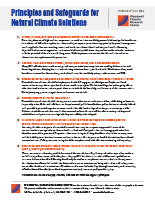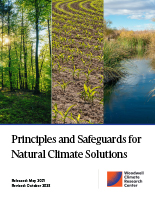Ensure that carbon credits used to finance natural climate solutions meet highest standards of quality, integrity, and offset eligibility.
Prepared by Glenn Bush, Jonathan Sanderman, and Wayne Walker
Summary
There are numerous financing models for natural climate solutions. Regulatory and voluntary carbon markets could be a significant source of funding for scaling up NCS, but their use needs to follow strict guidelines to ensure real climate benefits. Offsetting should only be used as a complement to—not substitute for—rigorous decarbonization efforts; this includes both immediate use as emissions are being reduced, as well as long-term use to offset hard-to-abate emissions. All carbon credits must be backed by thorough monitoring and accounting of both risks and benefits (as outlined in previous sections) to ensure quality and integrity.
Introduction
Well-made investments in nature can provide emissions abatement, as well as an array of co-benefits (Cook-Patton et al. 2021), including improved biodiversity, soil health, and water quality (Lawrence et al. 2022). Carbon markets offer a near-term source of financing for scaling up NCS that can subsequently help close the biodiversity finance gap, which was recently estimated at $722–$967 billion per year over the next 10 years (Adams et al. 2021). At 7 GtCO2 in annual potential by 2030, with an illustrative average price of $20 per ton, capital flows toward NCS could exceed $100 billion by 2030.
Opportunities to deploy these funds exist across the world, especially in tropical, less-developed countries. In particular, rural communities can benefit from the climate resilience that NCS can create, as well as from potential direct investment in sustainable livelihood and rural enterprise activities that address the local drivers of deforestation and land degradation. Restored coastal wetlands, for example, can absorb incoming wave energy, reduce flood damage, and provide protection from storms (Lovelock and Duarte 2019); healthier soil increases the resilience of cropland (Kane et al. 2021; Rojas et al. 2016); and fire management can mitigate the risk of catastrophic wildfires (Elder et al. 2022; Phillips et al. 2022).
However, voluntary carbon markets have faced intense scrutiny and criticism for a lack of transparency and integrity. These problems are real, but not insurmountable. Data and guardrails are needed to ensure carbon market investments in NCS produce the intended benefits—and do not cause harm to communities or ecosystems. Specifically, to be effective as a tool for global decarbonization, carbon offsetting with NCS should only be used to complement—not substitute for—rigorous decarbonization efforts; this includes both immediate use as emissions are being reduced, as well as long-term use to offset hard-to-abate emissions. Furthermore, the carbon and co-benefit performance of NCS must be assessed and monitored rigorously.
However, the effectiveness of carbon crediting as a tool for decarbonization is only achieved when it follows a set of narrow carbon accounting constraints, and when credits are appropriately priced.
A carbon offset credit represents an emission reduction of 1 metric ton of carbon dioxide (CO2) or carbon dioxide equivalent (CO2e). An individual, a business, or government can compensate for their carbon emissions by paying another entity to reduce or remove a matching quantity of greenhouse gasses from the atmosphere. When the number of carbon offset credits an individual or organization has obtained is equal to their residual carbon footprint, that person, activity, or organization is considered carbon neutral. Carbon offset revenue is typically invested into land management activities that provide durable mitigation outcomes. Critically, the reduction in greenhouse gas emissions from these projects counts toward the carbon balance of the person or government buying the offset, rather than the entity operating the project or the place where it is implemented.
Carbon credit quality and integrity
A buyer should have high confidence that a carbon credit is in fact equivalent to 1 ton of CO2. There has been a rapid evolution of guidelines and best practices to define high-integrity carbon credits from natural landscapes; perhaps the most comprehensive are issued by the Integrity Council for the Voluntary Carbon Market (ICVCM). ICVCM is an independent governance body for the voluntary carbon market established to set and enforce definitive global threshold standards so that high-quality carbon credits channel finance towards genuine and additional greenhouse gas reductions and removals. The ICVCM’s Core Carbon Principles (CCPs) set threshold standards for high-quality carbon credits with the objective to define which carbon-crediting programs and methodology types are CCP-eligible, i.e., meet or exceed the minimum set of CCP standards5. The CCPs consist of 10 components focusing on the supply of carbon from project/program operations:
- Quality and risk of reversal
- i. Additionality
- ii. Permanence
- Impacts in achieving climate and social objectives
- i. Mitigation activity information
- ii. Robust quantification of emission reductions and removals
- iii. Sustainable development impacts and safeguards
- iv. Transition towards net-zero emissions
- Accountability
- i. No double counting
- ii. Programme governance
- iii. Registry
- iv. Robust independent third-party validation and verification
The CCPs establish a consistent and standardized guide to assess high quality carbon credits issued under voluntary schemes, such as Verra and Gold Standard. This is an essential step to drive alignment across the voluntary carbon market programs by establishing a definitive and consistent global benchmark for high-integrity carbon credits. In order to maintain the legitimacy of “off-setting”—using carbon credits to support net zero or carbon neutral goals—it is critical that integrity is at the heart of future market development. Increasingly, there will be greater focus from regulators, investors and broader civil society on the quality of the credits that are being used for these purposes. Corporations seeking to purchase carbon credits need to be aware of the increased scrutiny that is likely to occur in relation to claims about the use of credits and the quality of the credits that underpin those claims.
While global benchmark standards for carbon market integrity such as the CCPs are critical, once established, the next challenge is accurate, verifiable measurement and reporting of performance against the standards. Market uncertainty stemming from concerns about permanence, leakage, and accountability is already apparent with regard to decarbonization commitments, and the lack of transparency exacerbates investor reticence.
Verification methodologies can be strengthened and processes streamlined. Independent assessment and oversight would build investor confidence. Clearer demand signals would help give suppliers more confidence in their project plans and encourage investors to better understand the value proposition (carbon quality, social and environmental co-benefits) of the variety of credits in the market. That in turn will lead to a clearer understanding of a credit’s value and variable pricing due to “known” quality and risk surrounding investment. On the supply side, actors in the landscape would be able to better align their investments to deliver credits of a given standard and be able to make informed decisions about the cost effectiveness and prospects of engaging in the carbon market compared to other land uses.
5 https://icvcm.org/wp-content/uploads/2023/03/CCP-Book-FINAL-27Mar23.pdf





